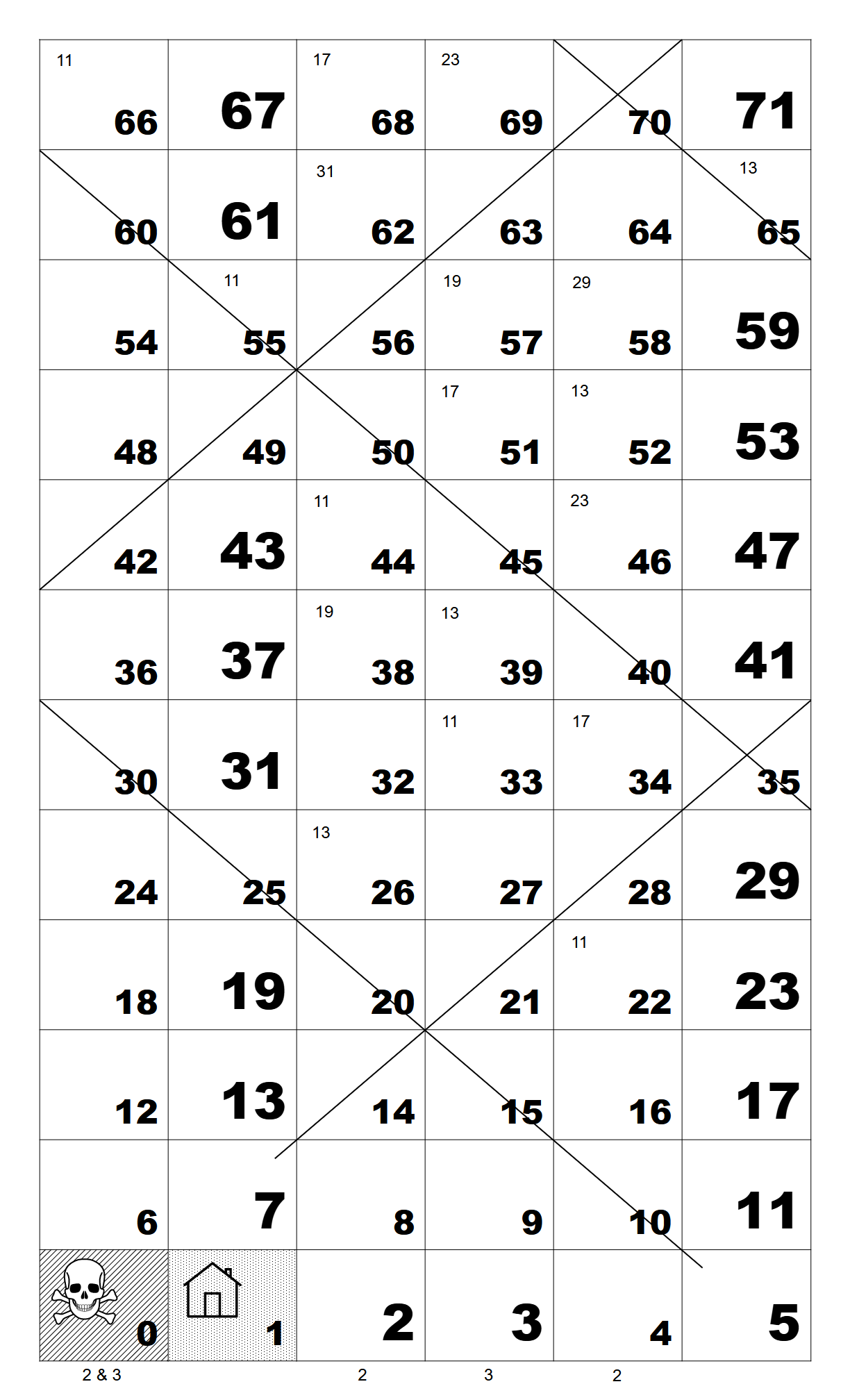
Man Home is an educational math board game that employs both chance and strategy.
Number of Players: 2+
What you will need:
1x 6-sided die
1x 12-sided die
5x playing pieces for each player
1x game board
You can print your own game board on legal-sized paper: PDF
Overview: Each player has 5 "pieces". A roll of the dice sends them to random numbers on the board. The goal is to bring your pieces Home (land on 1) while avoiding 0 and being killed by your opponents, all while getting to know the prime factors of numbers along the way. If you lose 3 of your pieces, you are out of the game. The last player standing, or the first player to bring 3 of their pieces home, wins the game.
Setup: Place the gameboard on a table. Each player places their 5 pieces in front of them. Any number of people may play as long as they each have 5 matching pieces. Outside of the gameboard, designate a "Winners' Circle" for those who made it home, and a "Cemetery" for those men who have died.

About the board: The prime numbers are slightly larger than the composite numbers. The diagonal lines are multiples of 5 and 7. Under the columns, there are labels for 2 and 3, indicating a common factor for every number in that column.
Start: Each player rolls the 12-die. The player who rolled the largest number goes first. Play continues counter-clockwise. In subsequent games, the winner of the previous game goes first. Each player rolls out a new playing piece on their first turn (see option 1 below).
Turn: Choose one of the 2 options below. Then, your turn normally ends and play passes to the player on the right (counter-clockwise). But, if you bring a piece home or kill an opponent, take another turn immediately.
[1] Roll a new playing piece: If you have no pieces on the board, this is your only option. Roll the 12 and 6 dice to determine where your piece lands. The 12-die goes up in multiples of six (12=0). The 6-die goes right in increments of one (6=0). Place your new playing piece there. If the space is occupied, see "Collisions".
[2] Roll an action: The 6-die determines what action you will take. See "Actions".
Actions: Roll an action with the 6-sided die. You must choose one of your playing pieces to perform the action, even if it results in death. Take the action on the number that the piece currently occupies to take you to your destination.
1 or 5 = subtract by one
2 or 4 = subtract by a prime factor
3 or 6 = divide by a prime factor
"Subtract by prime factor" example: If your piece is on 18, your unique prime factors are 2 and 3. Subtract 2 to place your piece on 16, or subtract by 3 to place your piece on 15.
"Divide by prime factor" example: If your piece is on 44, you may divide by 2 and place your piece on 22, or you divide by 11 and place your piece on 4.
Collisions: Only one playing piece can occupy a given number. If you move to a number that is occupied by one of your own pieces, one of them must die (see "Death"). If it is occupied by an opponent, possession of the space is decided by a face-off. The attacker and the defender of the space both roll a 6-sided die. Whoever rolls the largest number, takes the space, whilst the loser dies (see "Death"). The defender of the space always wins a tie.
Home "1": This is where you want to be. Upon arrivng Home, place your playing piece in the Winners' Circle.
Death "0": Landing on zero results in death. Place the deceased playing piece in the Cemetery. If it is your third piece in the cemetery, you have lost the game. Remove any remaing pieces from the board, and wait for the next game.
The End: The last player standing, or the first player to bring 3 of their playing pieces Home, wins the game!
I designed this game to help us all be more mindful of the primes that hide in everyday numbers. I also wanted to showcase the number line in a senary (base six) fashion. Notice how all the primes greater than 3 are some multiple of six plus or minus one. Notice how each of those primes' mulitples traverse up the senary number line either to the right or left in elegant diagonal moves, like chess knights with super powers.
Here are a couple videos to help conceptualise this: Intro to Senary Primes: Part 1 | Part 2
-David James Call